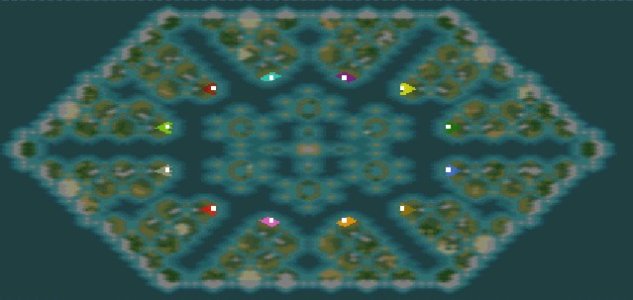Map Notes for Strategic Game Board #7:
=Map Stats=
- Map designed for 12 civs. Playable by up to 12 civs.
- Overall size 140x140. (default 'large' map setting)
- 12 player start locations
- 'Board Game' style layout, using 108 hexagons
=Geometry=
Why hexes? Particularly on a naval map?
I like the hex pattern for three reasons:
1) defensive choke points.
2) fresh water lakes. (very handy)
3) fast layout. I can make maps much faster using the hex pattern as a template.
Other benefits of the hex pattern as applied to this map are included in the strategy tips below.
In a 'full' map, hexagons would connect at six points to neighboring game hexes, with a small land bridge connecting three hexes at each corner. Not all land bridges are in place on this board, but each hex is still connected to at least two other hexes.
The map is made up of 108 hexes. There is one huge inland sea, with many extensions reaching to every corner of the map. There are twelve peninsulas extending from the outside edge of the map into this sea, and at the center are numerous islands.
Each peninsula has a start position located at the tip, as close to the center of the map as I could get it. The start positions are thus very close to one another, but are also fairly far apart using land routes. (start positions should be visible on the mini-map screenshot above.)
=Resources=
Most resources on this map are placed in clusters of three. If you find an oil cluster, for example, you not only meet your own needs but have two surplus oil to trade. There is also a possibility that two civs could split control of a cluster, sharing the same oil field, so to speak.
There are six clusters of each strategic resource. Starting from the start positions near the center, clusters are placed in roughly concentric rings, with the first-visible resources at the inside and more modern resource along the outside edge. Every start position has close access to *either* horses *or* iron.
There are four clusters of each luxury resource. These are placed more or less randomly across the board.
Also, 'bonus' resource placements can be found on the islands in the center of the map. There are two placements for each strategic resource, and one placement of each luxury.
Overall, resources should seem balanced for 8 civs.
=Strategy=
This map is designed to encourage naval engagements. You get only half of the resources you need to start off with, and the distances between civs have been calculated to make movement easy by water, more difficult by land. I've also used the editor to tweak the AI a bit, to encourage production of naval units.
Everyone starts out at the extreme end of their own peninsula. Your closest neighbors are just 10 or so moves away (in a direct line), but you have to either walk up one peninsula and down the other, or start building boats. Of your two nearest neighbors, one is easily accessable by galley. Everyone else isn't. Until you research navigation or build the Lighthouse, you may end up sinking a lot of galleys.
Not that the land route is completely out of the question. Each peninsula is linked to it's neighbors by a thin mountain land bridge. This *is* the long way around, but the option is still open. (Ask Hannibal and his elephants.)
The islands in the center of the map include 6 atolls, each surrounding a fresh water lagoon. These islands are rich in resources, and can also serve as advance military bases. Late in the game the island resources can be vital, since it may be easier to take the island cities to get a resource, rather than mount an offensive on your opponents mainland.
Some other fun things to do in this water park:
- Go jump in a lake. Several islands have lagoons, and each peninsula has numerous lakes. Building your cities along the lakes not only makes irrigation easier, but with a bit of advance planning you can shuttle ships from sea to lake and back again.
- Build canals. With a city on either side of certain lakes to act as 'locks' you can cut across the peninsulas rather than sail the long way around.
- Take the corners. You can sail right up to the edge of the board at each corner. Found a city there and charge tolls for anyone crossing the bridge. (You might also notice that the modern strategic resources are located near the corners as well.)
- Naval Blockades. Most coastal cities can be blocked by just a few ships. Narrow inlets can be blocked by 3-5 ships. Even the widest sections of the sea can be blocked, though it may take a dozen ships or so. You can block one half of the map from the other with less than 40 ships. (the shortest line I've found would need 34 ships, though if you've built that many ships I'm sure you have other plans for them.)
 That makes two out of the SGB series. Not that I'm bragging... much... o.k., so I'm bragging.
That makes two out of the SGB series. Not that I'm bragging... much... o.k., so I'm bragging. 
 I can't believe I left that out -- it's pretty much a must for a naval map.
I can't believe I left that out -- it's pretty much a must for a naval map.  That makes two out of the SGB series. Not that I'm bragging... much... o.k., so I'm bragging.
That makes two out of the SGB series. Not that I'm bragging... much... o.k., so I'm bragging. 
 I can't believe I left that out -- it's pretty much a must for a naval map.
I can't believe I left that out -- it's pretty much a must for a naval map. 

